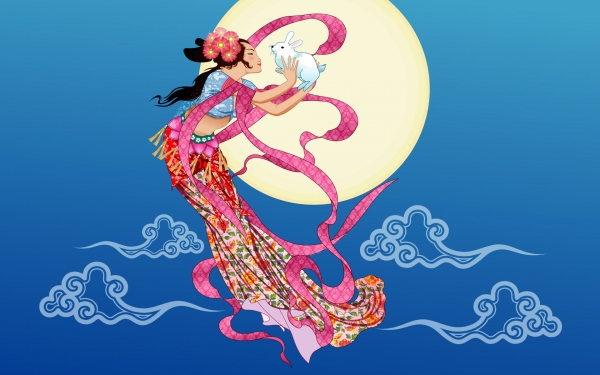|
Mid-autumn Festival
The Mid-Autumn Festival (Chinese Moon Festival) is an important traditional festivity second only to the Spring Festival.
Celebrated on the 15th day of the eighth month in Chinese lunar calendar, the Moon Festival usually comes sometime between the second week of September and the second week of October.
Mid-Autumn day is a time when people celebrate the harvest, enjoy the getting-together with families and friends and appreciate good food and the most beautiful moon.
Chinese ancestors took the seventh, eighth and ninth lunar months as autumn and 15th day of the eighth lunar month as the Moon Day which was considered the best day of the year to enjoy the beautiful, round and bright moon.
A harvest festival, Moon Day is a time for relaxation and celebration and most importantly, reunion of families. In the past, food offerings were placed on an altar set up in the courtyard. Special food for the festival included moon cakes and cooked taro, edible snails from the taro patches or rice paddies cooked with sweet basil, and water caltrope, a type of water chestnut resembling black buffalo horns. Some people insisted that cooked taro be included because at the time of creation, taro was the first food discovered at night in the moonlight.
Tradition
The Mid-Autumn Festival is a traditional festivity for both the Han and minority nationalities. The custom of worshipping the moon can be traced back as far as the ancient Xia and Shang Dynasties (2000 B.C.-1066 B.C.). In the Zhou Dynasty (1066 B.C.-221 B.C.), people held ceremonies to greet winter and worshiped the moon whenever the Mid-Autumn Festival set in. It became prevalent in the Tang Dynasty (618-907 A.D.) that people enjoyed and worshiped the full moon. In the Southern Song Dynasty (1127-1279 A.D.), however, people sent round moon cakes to their relatives as gifts in expression of their best wishes of family reunion. At night they looked up at the full silver moon or went sightseeing to celebrate the festival. Since the Ming (1368-1644 A.D. ) and Qing Dynasties (1644-1911A.D.), the custom of Mid-Autumn Festival celebration became unprecedented popular. Together with the celebration there appeared some special customs in different parts of the country, such as burning incense, planting Mid-Autumn trees, lighting Lanterns on towers and fire dragon dances. What is worth mentioning is that the Yuetan Park in the western district of Beijing, was originally the Temple of Moon, and every year, the emperor would go there to offer a sacrifice to the moon.
In mid-autumn farmers had just finished gathering their crops and bringing in fruits from the orchards. They were overwhelmed with joy when they have a harvest and at the same time they felt quite relaxed after a year of hard work. So the 15th Day of the eighth lunar month has gradually evolved as a widely celebrated festival for ordinary people. When the night falls, the land is bathed in silver moonlight. Families set up tables in their courtyards or sit together on their balconies chatting and sharing offerings to the moon. Together they enjoy the spell of night.

Moon Cake
Moon cake also has a story. During the Yuan dynasty (A.D.1280-1368) China was ruled by the Mongolian people. Leaders from the preceding Sung dynasty (A.D.960-1280) were unhappy at submitting to foreign rule, and set how to coordinate the rebellion without it being discovered. The leaders of the rebellion, knowing that the Moon Festival was drawing near, ordered the making of special cakes. Contained in each moon cake was a message with the outline of the attack. On the night of the Moon Festival, the rebels successfully attacked and overthrew the government. What followed was the establishment of the Ming dynasty (A.D. 1368-1644). Today, moon cakes are eaten to commemorate this legend.
The round moon cakes, traditionally about three inches in diameter and one and a half inches in thickness, resembled Western fruitcakes in taste and consistency. These cakes were made with melon seeds, lotus seeds, almonds, minced meats, bean paste, orange peels and lard. A golden yolk from a salted duck egg was placed at the center of each cake, and the golden brown crust was decorated with symbols of the festival. 13 moon cakes were piled in a pyramid to symbolize the thirteen moons of a "complete year", that is, twelve moons plus one intercalary moon.
Moon View
A moon view is a must in the Mid-Autumn Festival when the moon is especially round and bright. If the weather remains fine, people will be able to see a full moon on Mid-autumn day astronomers say. A full moon usually falls on the 16th day of a lunar month, instead of the 15th day. The moon will appear at its fullest when it is most closely aligned with the earth and the sun. It takes about 29.5 days for the three celestial bodies to be approximately aligned. The next time for such a fullest moon will be September 19, 2013. 【已有很多网友发表了看法,点击参与讨论】【对英语不懂,点击提问】【英语论坛】【返回首页】
|